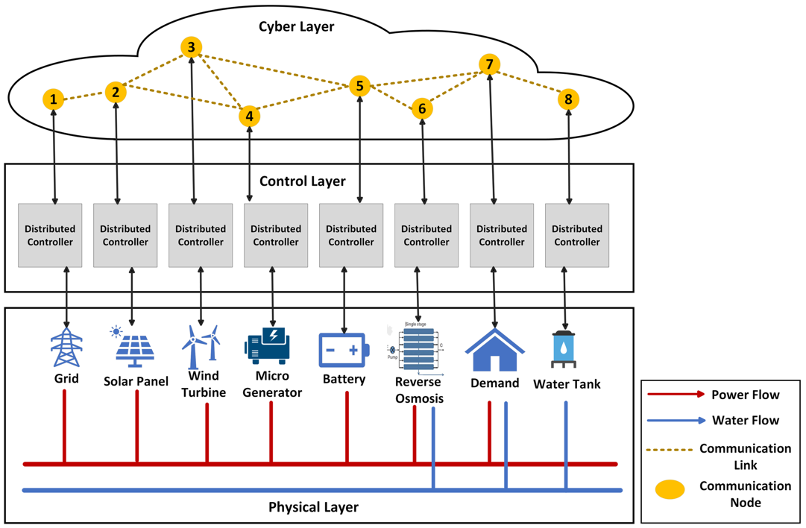Four conference papers from the ADAC lab are accepted by the 51st IEEE Annual Conference of the IEEE Industrial Electronics Society (IECON 2025) in Madrid, Spain.
1. Hierarchical Ensemble Based Clustering For Networked Microgrids (Aditya Joshi, Mo-Yuen Chow)
In last decade, global industrialization along with economic expansion have driven a significant increase in electricity demand worldwide. This surge presents a dual challenge: meeting growing energy needs while maintaining a reliable infrastructure. Over the last decade, the energy industry has experienced significant changes, notably through the growing integration of distributed energy resources (DERs) into the power grid. Networked microgrids have played pivotal role in enabling seamless integration of DERs into the power grid. Conversely, managing such a large-scale cyber-physical system of DERs in a distributed environment presents significant challenges in terms of scalability and convergence time of algorithm. In this context, a Hierarchical Distributed Consensus (HDC) based Energy Management System (EMS) has emerged as a promising solution.
A key prerequisite to ensure an effective implementation of the HDC based EMS is to obtain an optimal hierarchical partition from the network. Manually, evaluating cluster quality for each cluster count requires extensive exploratory effort and is computationally inefficient. Moreover, arbitrarily setting cluster counts becomes impractical for large-scale networks with high node magnitudes, underscoring the need for a sophisticated approach.
This paper proposes a hierarchical ensemble-based method for determining optimal number of clusters in networked microgrid networks. The proposed method incorporates dynamic cluster evaluation and consensus matrix construction based on which elbow method and hierarchical dendrogram are used to determine the optimal cluster formation. The comparative analysis affirms the optimality of the proposed method by examining the influence of cluster configuration on speed of convergence.

2. Impact of Communication Link Failures on Distributed Energy Management in Disaster Relief Microgrids (Hengrui Tian, Aditya Joshi, Mo-Yuen Chow)
Power restoration is a critical priority following disasters, and microgrid-based approaches present a promising solution for enabling rapid and timely resource recovery. However, in distributed microgrid environments, overall system performance heavily depends on the efficiency and reliability of the underlying communication network. Identifying critical communication links can help better coordinate the limited resources available in post-disaster scenarios. The Connectivity Rank Index (CRI) has been established as an effective edge centrality metric for evaluating communication links in distributed energy management systems. This paper introduces a variant called Local-CRI, specifically designed for hierarchical distributed network architectures. Numerical simulations confirm that CRI accurately captures the importance of communication links in relation to consensus performance, outperforming existing methods. Furthermore, Local-CRI effectively quantifies the impact of communication link failures on consensus convergence, particularly within hierarchical distributed networks.

3. Weight Matrix Construction for Distributed Consensus Algorithm in Water-Energy Nexus: Convergence and Robustness (Ahmad ALhaji, Alexandra Duel-Hallen, Mo-Yuen Chow)
Freshwater scarcity continues to pose a significant threat to communities worldwide. With the growing integration of distributed energy resources (DERs), there is an increasing opportunity to couple energy generation with desalination technologies to meet water and energy demands in a unified system. This paper investigates the convergence behavior of distributed consensus algorithms in such coupled water-energy systems, where the interconnection between energy and water processes introduces additional complexity. Specifically, the study examines the impact of different weight-matrix-construction schemes on the convergence speed of the distributed consensus algorithm and its robustness to packet loss. The simulation results show that using the optimal-constant-weight scheme achieves the fastest and most robust convergence but requires global knowledge of the network. However, the maximum-constant-weight scheme, despite requiring global information, has slower convergence speed and is more sensitive to packet loss. In contrast, the local-degree-weight scheme provides comparable performance to the optimal-constant-weight scheme without requiring the system’s global information.

4. Robust Real-Time SOH Estimation via Online Identification of Temperature and SOC Dependent Battery Resistance Model (Skieler Capezza, Mo-Yuen Chow)
Real-time and accurate health estimation of lithium-ion batteries is necessary to ensure the safe and continuous operation of critical systems such as microgrid energy storage systems and modern electric/hybrid vehicles. Estimation of a battery’s state-of-health (SOH) requires online identification of battery model parameters such as internal resistance or battery capacity. Although many papers discuss either the estimation of these parameters in real-time or the identification of these parameter changes at different operating conditions, a unified framework for SOH estimation considering battery states and environmental conditions has not been widely accepted in the field. This paper focuses on the development of a novel methodology for online SOH estimation for lithium-ion batteries utilizing a nonlinear model for electric circuit model (ECM) resistances with dependencies on temperature and state-of-charge (SOC).

